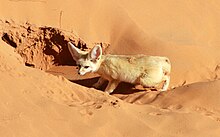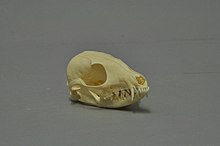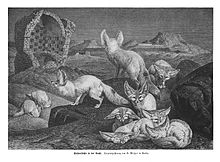
The Arctic fox, also known as the white fox, polar fox, or snow fox, is a small species of fox native to the Arctic regions of the Northern Hemisphere and common throughout the Arctic tundra biome. It is well adapted to living in cold environments, and is best known for its thick, warm fur that is also used as camouflage. It has a large and very fluffy tail. In the wild, most individuals do not live past their first year but some exceptional ones survive up to 11 years. Its body length ranges from 46 to 68 cm, with a generally rounded body shape to minimize the escape of body heat.

Canidae is a biological family of dog-like carnivorans, colloquially referred to as dogs, and constitutes a clade. A member of this family is also called a canid. The family includes three subfamilies: the Caninae, the extinct Borophaginae and Hesperocyoninae. The Caninae are known as canines, and include domestic dogs, wolves, coyotes, foxes, jackals and other species.

Foxes are small to medium-sized, omnivorous mammals belonging to several genera of the family Canidae. They have a flattened skull, upright, triangular ears, a pointed, slightly upturned snout, and a long bushy tail ("brush").
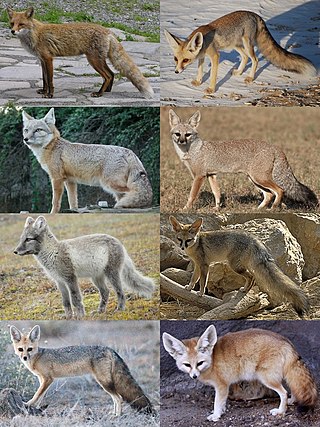
Vulpes is a genus of the sub-family Caninae. The members of this genus are colloquially referred to as true foxes, meaning they form a proper clade. The word "fox" occurs in the common names of all species of the genus, but also appears in the common names of other canid species. True foxes are distinguished from members of the genus Canis, such as domesticated dogs, wolves, jackals and coyotes, by their smaller size (5–11 kg), longer, bushier tail, and flatter skull. They have black, triangular markings between their eyes and nose, and the tip of their tail is often a different color from the rest of their pelt. The typical lifespan for this genus is between two and four years, but can reach up to a decade.

The sand cat is a small wild cat that inhabits sandy and stony deserts far from water sources. With its sandy to light grey fur, it is well camouflaged in a desert environment. Its head-and-body length ranges from 39–52 cm (15–20 in) with a 23–31 cm (9.1–12.2 in) long tail. Its 5–7 cm (2.0–2.8 in) short ears are set low on the sides of the head, aiding detection of prey moving underground. The long hair covering the soles of its paws insulates its pads against the extreme temperatures found in deserts.

The maned wolf is a large canine of South America. It is found in Argentina, Brazil, Bolivia, Peru, and Paraguay, and is almost extinct in Uruguay. Its markings resemble those of foxes, but it is neither a fox nor a wolf. It is the only species in the genus Chrysocyon.

The bat-eared fox is a species of fox found on the African savanna. It is the only extant species of the genus Otocyon and considered a basal canid species. Fossil records indicate this canid first appeared during the middle Pleistocene.

The kit fox is a fox species that inhabits arid and semi-arid regions of the southwestern United States and northern and central Mexico. These foxes are the smallest of the four species of Vulpes occurring in North America and are among the smallest of the vulpines worldwide. It has also been called a North American counterpart of the fennec fox due to its large ears.

The swift fox is a small light orange-tan fox around the size of a domestic cat found in the western grasslands of North America, such as Montana, Colorado, New Mexico, Kansas, Oklahoma and Texas. It also lives in southern Manitoba, Saskatchewan and Alberta in Canada, where it was previously extirpated. It is closely related to the kit fox and some mammalogists classify them as conspecific. However, molecular systematics imply that the two species are distinct. Interbreeding between the two species does occur where their ranges overlap, but this hybridization is quite restricted in scope.
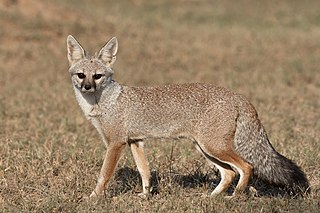
The Bengal fox, also known as the Indian fox, is a fox endemic to the Indian subcontinent from the Himalayan foothills and Terai of Nepal through southern India, and from southern and eastern Pakistan to eastern India and southeastern Bangladesh.

The Cape fox, also called the asse, cama fox or the silver-backed fox, is a small species of fox, native to southern Africa. It is also called a South African version of a fennec fox due to its similarly big ears. It is the only "true fox" occurring in sub-Saharan Africa, and it retains primitive characteristics of Vulpes because it diverged early in the evolutionary history of the group.
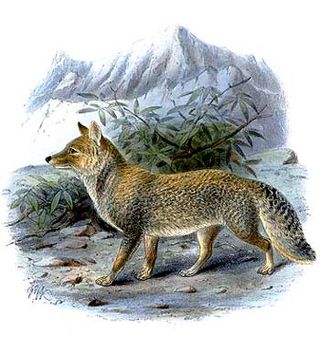
The Tibetan fox, also known as the Tibetan sand fox, is a species of true fox endemic to the high Tibetan Plateau, Ladakh plateau, Nepal, China, Sikkim, and Bhutan, up to elevations of about 5,300 m (17,400 ft). It is listed as Least Concern in the IUCN Red List, on account of its widespread range in the Tibetan Plateau's steppes and semi-deserts.

Blanford's fox is a small fox native to the Middle East and Central Asia. It is listed as Least Concern on the IUCN Red List.

The hoary fox or hoary zorro, also known as raposinha-do-campo in Brazil, is a species of zorro or "false" fox endemic to Brazil. Unlike many other foxes, it feeds primarily on small invertebrates such as insects.
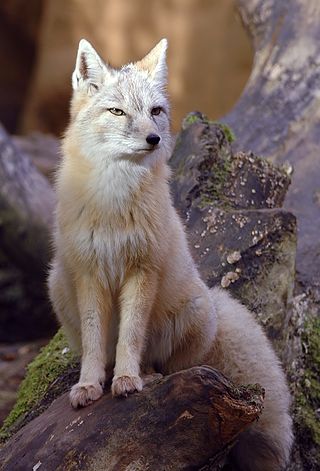
The corsac fox, also known simply as a corsac, is a medium-sized fox found in steppes, semi-deserts and deserts in Central Asia, ranging into Mongolia and northern China. Since 2004, it has been classified as least concern by IUCN, but populations fluctuate significantly, and numbers can drop tenfold within a single year. It is also known as the steppe fox. The word "corsac" is derived from the Russian name for the animal, "korsák" (корса́к), derived ultimately from Turkic "karsak".
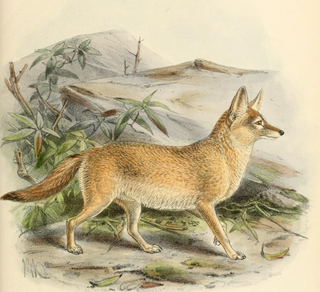
The pale fox is a species of fox found in the band of African Sahel from Senegal in the west to Sudan in the east. It is one of the least studied of all canid species, in part due to its remote habitat and its sandy coat that blends in well with the desert-like terrain.

Rüppell's fox, also called Rüppell's sand fox, is a fox species living in desert and semi-desert regions of North Africa, the Middle East, and southwestern Asia. It has been listed as Least Concern on the IUCN Red List since 2008. It is named after the German naturalist Eduard Rüppell.

The red fox is the largest of the true foxes and one of the most widely distributed members of the order Carnivora, being present across the entire Northern Hemisphere including most of North America, Europe and Asia, plus parts of North Africa. It is listed as least concern on the IUCN Red List. Its range has increased alongside human expansion, having been introduced to Australia, where it is considered harmful to native mammals and bird populations. Due to its presence in Australia, it is included on the list of the "world's 100 worst invasive species".

The African wolf is a canine native to North Africa, West Africa, the Sahel, northern East Africa, and the Horn of Africa. It is listed as least concern on the IUCN Red List. In the Middle Atlas in Morocco, it was sighted in elevations as high as 1,800 m (5,900 ft). It is primarily a predator of invertebrates and mammals as large as gazelle fawns, though larger animals are sometimes taken. Its diet also includes animal carcasses, human refuse, and fruit. They are monogamous and territorial; offspring remain with the parents to assist in raising their parents' younger pups.
